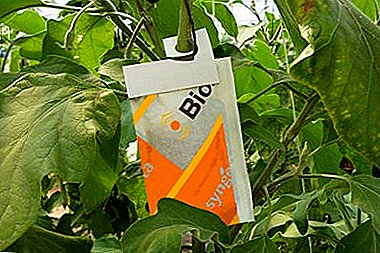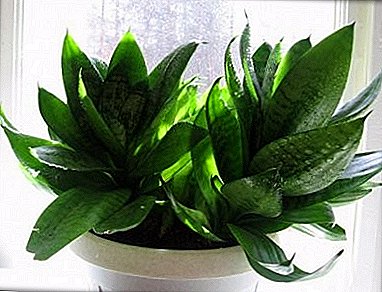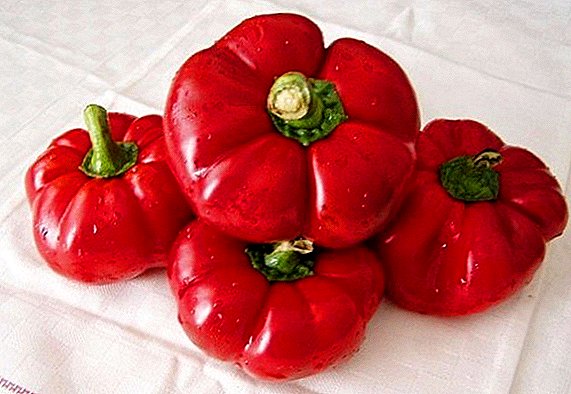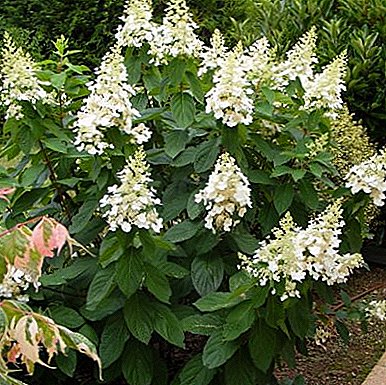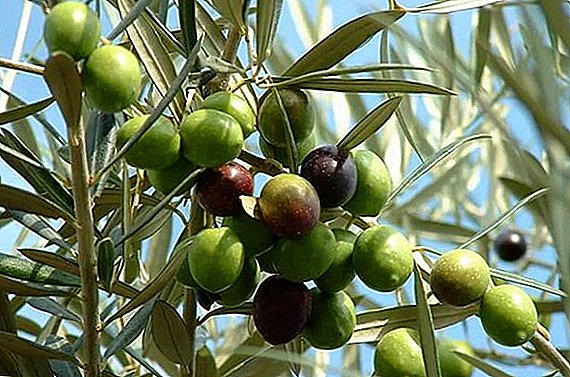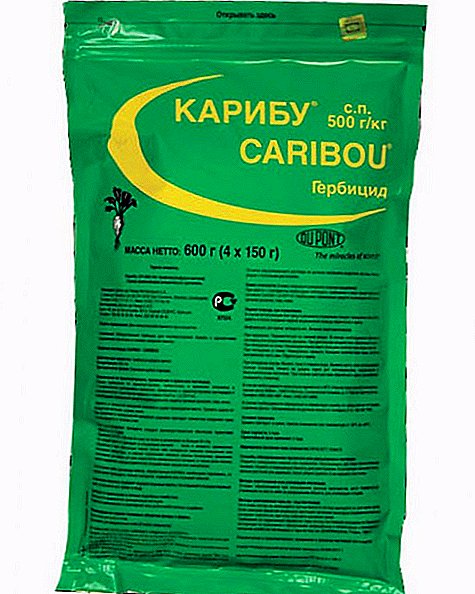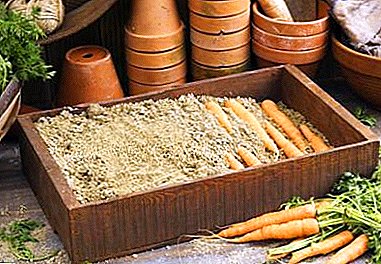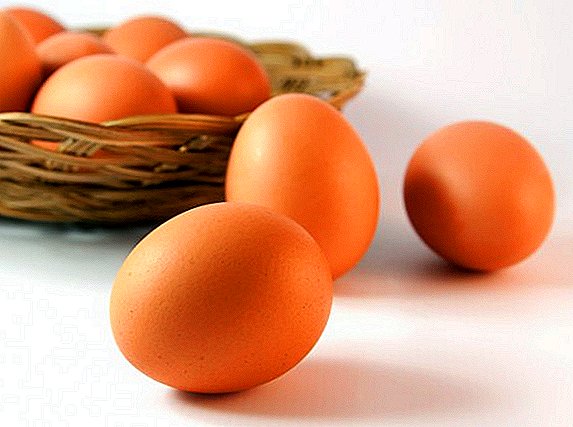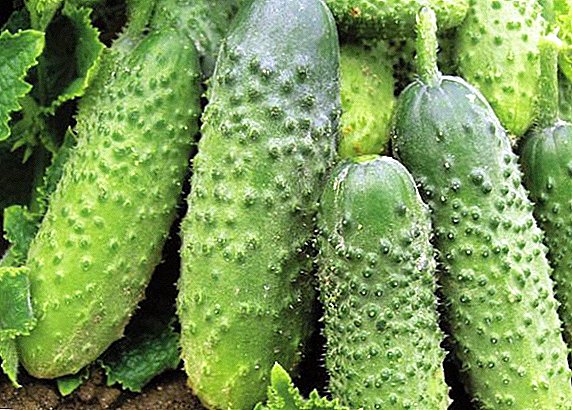 Cucumber - a popular vegetable crop grown in gardens, cottages, and even at home on the balconies. About this universality of the culture took care of the breeders who bred resistant and with a short growing season varieties. We will tell about one of the universal varieties in this article.
Cucumber - a popular vegetable crop grown in gardens, cottages, and even at home on the balconies. About this universality of the culture took care of the breeders who bred resistant and with a short growing season varieties. We will tell about one of the universal varieties in this article.
Variety description
"Murashka" - a hybrid variety of cucumbers. Treats such which do not need pollination by insects. This is a big plus if the culture is grown in isolated greenhouses.
Cucumber shrub grows medium in size, with abundant foliage and medium weight. The leaves have a rich green color, medium size, with a smooth surface. The ovary is formed from female flowers. In each sinus leaf may be 2-4 ovary.
The most fruitful hybrid varieties of cucumbers are: "German", "Real Colonel", "Courage", "Phoenix Plus", "Zozulya", "Siberian Festoon", "Hector", "Crispina", "Taganay", "Masha f1" .
Pros:
- early variety;
- high and consistent yield;
- resistance to many diseases;
- good taste;
- versatility.
 Disadvantages:
Disadvantages:
- for a good harvest you need to grow from seedlings;
- cultivation technology must be observed.
Did you know? In the Guinness Book of Records cucumber grown in Hungary. Its length - 183 cm
Fruit characteristics and yield
Fruits are fully formed 35-40 days after germination. They are cylindrical in shape, 10–12 cm long and 3–4 cm wide. Weigh 90–110 g. The rind is dark green, with tubercles with black spikes. The color goes smoothly from the light "nose" to the dark "ass". The flesh is sweetish, has no bitterness. The aroma is saturated.
From 1 square. m cucumber beds you can collect 10-12 kg of greens. Harvest time - July-August. 
Selection of seedlings
Before buying seedlings you need to decide where you will plant it. The youngest seedlings are planted in open ground, a little bit older - in greenhouses without heating, and the oldest in heated ones.
- Monthly saplings, if they developed well, will be 25-30 cm high. The underseed knee is no more than 5 cm long and 0.6-10 mm wide. A seedling of this age should have 5-6 leaves.
- The height of the 15-20-day-old seedlings is 15-20 cm with a knee subseed of 5 cm. These leaves 2-3.
- Even more young seedlings (10-12 days old) have 1 true leaf.
- The capacity in which the seedlings grow must be intact, free of defects.
- If white roots are visible on the walls of the pot, then root development is normal.
- The larger the seedling, the greater should be the capacity in which it is sold.
- On the seedlings should not be signs of the disease and traces of pests. Ailments appear as spots on the stems and leaves, and pests can deform the foliage.
- Elongated stems, pale color indicate that violations were made in the breeding of seedlings. You should not take such seedlings, they will not give a good harvest.
- The saturated color of foliage, curled down, indicates a plant oversaturation with nitrogen.
- If you plan to plant in open ground, then the seedlings should be hardened. Uncleaned has a weak root system.
Learn how to choose the right seedling container.
VIDEO: HOW TO CHOOSE THE BEST CROWN
Important! It is advisable to choose seedlings of about the same age, in order to ripen evenly.
Soil and fertilizer
The soil loves light and fertile. Sandy and loamy sandstone is best. Before planting the plant, the soil must be fertilized with humus. Acidity should be neutral.
Cucumbers grow best after cabbage and cauliflower, potatoes, legumes (except beans), and root crops (except carrots). Undesirable predecessors: zucchini, melons, watermelons, pumpkins, squash.
The selected plot of land for the bed of cucumbers is dug up in the fall. All weeds, stones and other debris are harvested. The land is enriched with compost, humus and mineral fertilizers. On 1 square. m bed requires 15 kg of humus / compost, 25 g of nitrogen and potash fertilizers. Finally, the site is watered with boiling water or a saturated solution of potassium permanganate. From above the ground is covered with a film until spring. 7 days before planting the soil is loosened. 
Growing conditions
The best place for planting cucumbers in open ground is a sunny, quiet place, preferably not in a lowland. Culture does not like drafts and constant wetting of the root system, but at the same time it is very moisture-loving. Heat transfers badly.
Planting seeds should be carried out when the earth warms to 18-23 ° C.
Growing from seed to seedlings at home
The highest yield is yielded by Murashka cucumbers grown from seedlings at home. Therefore, seedlings need to pay maximum attention.
Seed preparation
The most important step is seed preparation. Before planting, they must be treated with a solution of potassium permanganate (5 g per 500 ml of water) and soak for 12-20 hours. Further, in order for the seed to take root, it must be wrapped in a damp cloth and, while maintaining humidity, leave for 2-3 days in a room with a temperature of 25 ° C. In the meantime, the preparation of the tank and soil for planting is underway
Familiarize yourself with the characteristics of soaking cucumber seeds before planting.
 Potassium permanganate solution
Potassium permanganate solution
Content and location
The soil should be a mixture of turf and humus in a 1: 1 ratio. Ash can be added to the mixture (200 g per 10 l of the mixture). If you do not want to bother with the preparation of the soil, you can purchase a special substrate for seedlings. They or a mixture of filled pots for seedlings on 2/3 and make drainage holes.
Germinated seed is buried in damp ground for 1 cm. From above, the pots are covered with foil or glass and put in a warm dark place until the first shoots. Then the film is removed and transported seedlings to a bright place with a temperature of 16-20 ° C.
Important! If it is not enough sunny days, it is necessary to carry out lightening. Cucumbers need 12-14-hour light day.
Seed planting process
- Seeds are germinated.
- Planted them in pots, deepening 1 cm into the soil.
- Water and cover with foil or glass.
- Put in a dark warm place.
- When the first shoots appear, the film is removed and the seedlings are transported to a bright place.
- When the first true leaf appears, fertilize the seedling with manure diluted in water (1:12). The procedure is carried out in the morning on a warm sunny day. After 30 minutes after feeding the seedlings are watered.



Seedling care
The first watering of plants is done after 4-5 days from the moment of the first shoots. Water temperature should be 25-28 ° C. After each watering is loosening the soil. The frequency of watering depends on the rate of drying of the soil.
If over time the soil in the pot sagged and exposed the root system, it is necessary to fill up the ground. And so that young cucumbers do not attack the black leg, the stem is smeared with chalk powder, activated carbon powder or fine wood ash.
7-10 days before the proposed planting of seedlings in open ground, seedlings begin to harden in the fresh air. The first procedures should last no longer than 2-3 hours. Gradually, this time increases to 8-10 hours.
Transplanting seedlings to ground
When the soil has warmed up to 15 ° C, the seedlings can be planted in a permanent place. This temperature is set at about the end of May - the beginning of June. At this point, the seedlings should be 25 days old and have 2-3 true leaves.  The beds are watered and wells form a depth of 7-8 cm on it. They can be placed in a row or staggered, but you need to take into account the fact that it is 1 square meter. m should be no more than 3 plants. With this in mind, the distance between the holes will be about 70 cm.
The beds are watered and wells form a depth of 7-8 cm on it. They can be placed in a row or staggered, but you need to take into account the fact that it is 1 square meter. m should be no more than 3 plants. With this in mind, the distance between the holes will be about 70 cm.
In the hole poured a handful of humus and 1 tbsp. l Ash, immersed seedling. It is covered with earth on the lower cotyledon leaves.
Important! When moving the seedling from the pot to the hole, you must try not to shake the ground from the root system.
The planted plant is watered abundantly with a watering can. After the water is absorbed, a layer of mulch from peat or humus is laid out around the bush.
Agrotechnics growing seeds in open ground
The process of planting seeds in open ground is similar to planting them on seedlings. But there are temporary differences. In more detail we will tell further.
Outdoor conditions
Technologically, there is no difference between growing seeds in a greenhouse and in the open field. "Murashka" is a universal variety, therefore it grows well in any place. But it is worth considering that sowing seeds into open soil is possible only at a certain temperature. And in greenhouses, especially heated ones, this can be done at any time. Also in regions with a short warm period, seeds planted in the soil may not be able to produce a crop before the onset of cold weather. Therefore, each agronomist decides on his own where to plant.  We already said that cucumbers - light-loving and heat-loving culture. On this basis, in the northern and middle lane the beds should be located on the southern slope and in a place protected from cold winds. As a cozy place, lowlands and basins will not work, as cold air will collect in them. In the southern areas you can form a bed on flat areas, but protected from dry winds.
We already said that cucumbers - light-loving and heat-loving culture. On this basis, in the northern and middle lane the beds should be located on the southern slope and in a place protected from cold winds. As a cozy place, lowlands and basins will not work, as cold air will collect in them. In the southern areas you can form a bed on flat areas, but protected from dry winds.
The process of planting seeds in the ground
It is possible to carry out planting of seeds in open ground when the soil warms up to 18-23 ° C to a depth of 12-15 cm.
First, prepare the seed: sorted, germinated, hardened. The technique of seed preparation is similar to the preparation for planting seedlings.
The finished seed is planted either in the wells or in the grooves. The holes are made at a distance of 70-80 cm from each other, in a row or staggered. 8-10 seeds are poured into the hole and sprinkled with soil a little. When shoots appear, leave the 2-3 strongest plants and tie them to the support. Shoots should not interfere with each other.
VIDEO: LANDING OF CUCUMBERS IN AN OPEN GROUND If the sowing is done in the grooves, the seeds are laid out at a distance of 5 cm one from another. It is necessary to dig them into the soil by 3-4 cm. Gradually thin the seedlings. On one running meter of a bed it is necessary to leave 4-5 bushes of seedling.
Watering
Cucumbers love moisture, so it is desirable to water them every day. But do not strongly pour the plant, as its root system does not tolerate wetting. The best will be 20 liters of warm water per 1 square. When sprouts have a third leaf, the frequency of watering is reduced to 2-3 per week. At this interval, watering is conducted in a cool, rainy summer. Watered in the evening. If there is a strong heat, it is necessary to irrigate the crop twice a day, morning and evening.
Water the plant under the roots can not, because they are close to the surface. But they do not recommend getting water on the foliage, flowers and ovary. The best way to irrigate is drip, or it is worth building grooves along the beds and pouring water into them.
We recommend to learn how to organize drip irrigation at the site, and how to independently make drip irrigation from plastic bottles.
 Drip irrigation cucumber
Drip irrigation cucumber
Soil loosening and weeding
Loosen the soil after each watering and after heavy rains. During loosening between the rows, they are 4-8 cm deep into the soil. Along with the raising of the soil, weeding is done as necessary.
Masking
When pickling cucumbers, all lateral shoots are removed from the nodes of the lashes. You can do it by hand or cut off with a garden tool. Remove shoots should be when they have reached 3-6 cm in length. Previously, the procedure is meaningless, and later you can lose the harvest, as the plant will give all its strength not to the ovary, but to the shoots.
In addition to pinching, you need to deal with the formation of the bush. At the first stage, young plants with 5-6 true leaves are tied up. Further, when the main stem grows to 0.8–1 m, pinching of the side stems is performed. On the main stem leave 1 fruit ovary and 1 leaf.  When the bush grows to 1.5 m, its side shoots are shortened so that 2-3 ovaries with leaves are left on them. Subsequent side shoots gradually increase in length from 20-30 cm to 40-50. Top of the bush also pinch. This will allow you to redirect all the strength of the plant with the growth up to the growth of lateral shoots and the development of the ovary. The upper part of the bush up to 70 cm long (counting from the last lateral shoot) is twisted around the wire and fixed on a support. The rest is cut off.
When the bush grows to 1.5 m, its side shoots are shortened so that 2-3 ovaries with leaves are left on them. Subsequent side shoots gradually increase in length from 20-30 cm to 40-50. Top of the bush also pinch. This will allow you to redirect all the strength of the plant with the growth up to the growth of lateral shoots and the development of the ovary. The upper part of the bush up to 70 cm long (counting from the last lateral shoot) is twisted around the wire and fixed on a support. The rest is cut off.
Find out what are the differences in pinching cucumbers in the open field and in the greenhouse.
With the appearance of the first ovaries of the plant, the lower leaves (3-4 pieces) are also cut to ensure better ventilation of the bush.
Garter
The benefits of garter cucumbers:
- a tied bush may form longer side shoots on which more ovaries will appear;
- if a fungus or virus has infected a shrub, then healthy shoots will grow upwards and the infection will not spread;
- bush upright takes up less space;
- it is easier to harvest from an erect plant than from a reclining plant.
There are 3 main ways of garter cucumbers in open ground: horizontally, vertically and using the grid.
Horizontal Garter. For it is necessary to take 2 metal or wooden sticks and dig them into the ground at the edges of the beds. Stretch a string or rope between them in several rows. Between the ropes should be 25-30 cm. Carefully pull the plant stems to the bottom rope and fix them in this position. Gradually growing, the stem will braid the ropes. 
Important! It should be a high support, so that the long stem is not outweighed through it and did not create a shadow for himself. Or you need to remove extra shoots in time and shorten the main one.
Vertical garter. Just as in the first method, take 2 supports and install at the ends of the beds. At the very top, stretch the string and tie a 2-3 cm wide fabric strip over each bush. Tie the free edge of the strip around the base of the plant. Initially, you should periodically send the stalk so that it wraps around the strip.  Garter net. This method is similar to the previous one. Along the beds stretch a special mesh and fix the supports. Cucumber stem is sent to the net, and as it grows, it will braid it.
Garter net. This method is similar to the previous one. Along the beds stretch a special mesh and fix the supports. Cucumber stem is sent to the net, and as it grows, it will braid it. 
Top dressing
For cucumbers "Murashka" use root dressing. The foliar method is applicable in rainy and cold weather. It is best to conduct dressing on a cool evening on a cloudy day. Before the procedure, for 30 minutes, abundantly moisten the soil in the garden.
Nitrogenous fertilizers are applied under the crop before the onset of the flowering period. They help the bush to develop more intensively. The rest of the time they will only interfere with the formation of green leaves.
VIDEO: SUPPORTING CUCUMBERS DURING FLOWERING
Of the mineral fertilizers, carbamide, ammonium sulfate, and ammonium nitrate are most suitable. Dilute them to 10-15 g per 10 liters of water. Among the organics dominated infusion of a mixture of cow dung or chicken dung, nettle or dandelion leaves. It is necessary to insist for 2-3 days, and before use, dilute with water in a ratio of 1:10 or 1:15 (with droppings). You can add 10 g of nitrophoska per 10 liters.
During the flowering period, the plant is fed with infusion of wood ash (500 g cans of 3 liters of boiling water). You can use special fertilizers. During fruiting, 20-25 g of superphosphate and potassium sulfate diluted in 10 liters of water are introduced. Feed the variety "Murashka" every 12-15 days.
Pests, diseases and prevention
Such popular diseases as powdery mildew and olive spotting are not intimidating to the plant. But it is attacked by other diseases: downy mildew and root rot.
The main symptom of the first disease is yellowish spots with blurred edges, appearing on the leaves between the veins. Over time, they increase in size and quantity. Leaf turns brown, deforms and dries. Its surface is covered with small gray-black dots, mushroom spores. There is a disease due to excessive watering, cool rainy days, sharp temperature fluctuations.
Learn more about the symptoms, prevention and treatment of downy mildew on cucumbers.
 Downy mildew of cucumbers As a preventive measure, before planting, seed must be soaked in Fitosporine-M or Ridomile Gold for a quarter of an hour. The bushes themselves, every 10-12 days, must be sprayed with water with kefir or whey, mixed in a ratio of 1:10, with an iodine solution (10 drops per 10 liters of water).
Downy mildew of cucumbers As a preventive measure, before planting, seed must be soaked in Fitosporine-M or Ridomile Gold for a quarter of an hour. The bushes themselves, every 10-12 days, must be sprayed with water with kefir or whey, mixed in a ratio of 1:10, with an iodine solution (10 drops per 10 liters of water).
The fight against the disease is pruning the affected foliage and treating the plant with fungicides.
Suitable for spraying Bordeaux liquid, copper sulfate, "Horus", "Topaz", "Abiga-Peak", "Strobe."
In time, the observed disease will recede after 2-3 treatments with an interval of 5-7 days.
Root rot is manifested by slower growth, weakening of the plant, blackening of the base of the bush and the appearance of mold around the plant on the soil.  For prevention, sprinkle the bush and soil with fine ash, sulfur dust, chalk powder. The procedure is carried out 1 time in 1.5-2 weeks.
For prevention, sprinkle the bush and soil with fine ash, sulfur dust, chalk powder. The procedure is carried out 1 time in 1.5-2 weeks.
Treatment is effective only at the initial stage. They use "Alirin-B", "Previkur" 1 time in 4-6 days (until the symptoms disappear completely), and pour it with water, but with a weak solution of potassium permanganate. The duration of this watering - 14-28 days. With a strong defeat of culture, the struggle is useless. You can only pry and burn the bush, and disinfect the soil with a 24% solution of blue vitriol.
Harvesting and storage
It is possible to harvest greenhouses 43-48 days after germination. This is approximately July-August. The variety has a high yield. With one bush can collect up to 7.5 kg.Fruits are recommended to be collected at least once every 3-4 days. Then they will not be overripe, and new ones will start growing faster. It is better to carry out the harvest in the morning, then the greenhouses will be better preserved. It is better to cut the cucumbers, and not to tear them off, so the bush is injured less.
To keep the fruits lying longer, fill them with cool water and leave for a couple of days. Change water periodically. Then wrap each greenberry with wet gauze or a damp napkin, put it in a bag and put it in the fridge in the vegetable compartment. 
Possible problems and recommendations
To get a good harvest for cucumbers "Murashka" need the right care. This is perhaps the main problem of this class. Some gardeners may not like the continuous growth of the plant. Therefore, it is necessary to engage in forming a bush.
Did you know? In Turkey, when cucumbers were still a rarity, the Sultan Muhammad II, who ruled at that time, ordered his subjects to open his stomach, 7 because of his greed, in order to find out who ate one of the cucumbers he brought as a gift.
Recommendations:
- Do not plant bushes thickly, it contributes to the development of gray rot. Also, rot occurs in poorly ventilated greenhouses.
- Watch out for plant saturation with nitrogen. With its lack of greens will be pale, and the sheet is small. With an excess of it will acquire a rich color, and the sheet will be twisted.
- Try to maintain the temperature in the greenhouse at a certain level. If the plants are cold, they will slow down in growth. And in the heat will not form the ovary, and the flowers will fall.
- Control daylight hours. If the plant does not have enough light, then the ovary will begin to crumble.
- With a lack of potassium, the ovary may also fall off.
Most gardeners are satisfied with the variety of cucumbers "Murashka". This variety captivates with its versatility and active fruiting. And simplicity in sowing seeds will allow you to easily grow a culture even for a beginner agronomist.
Reviews




